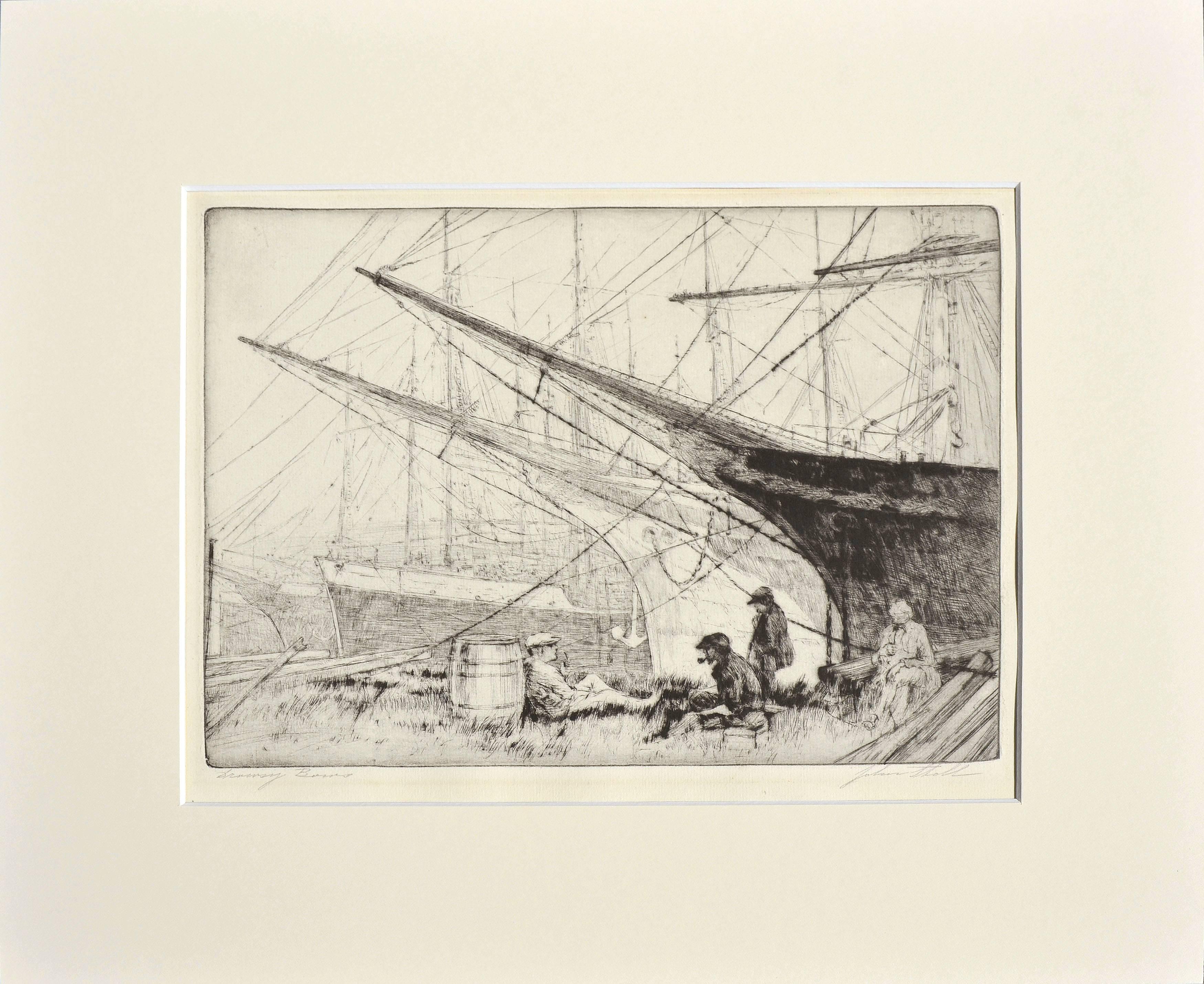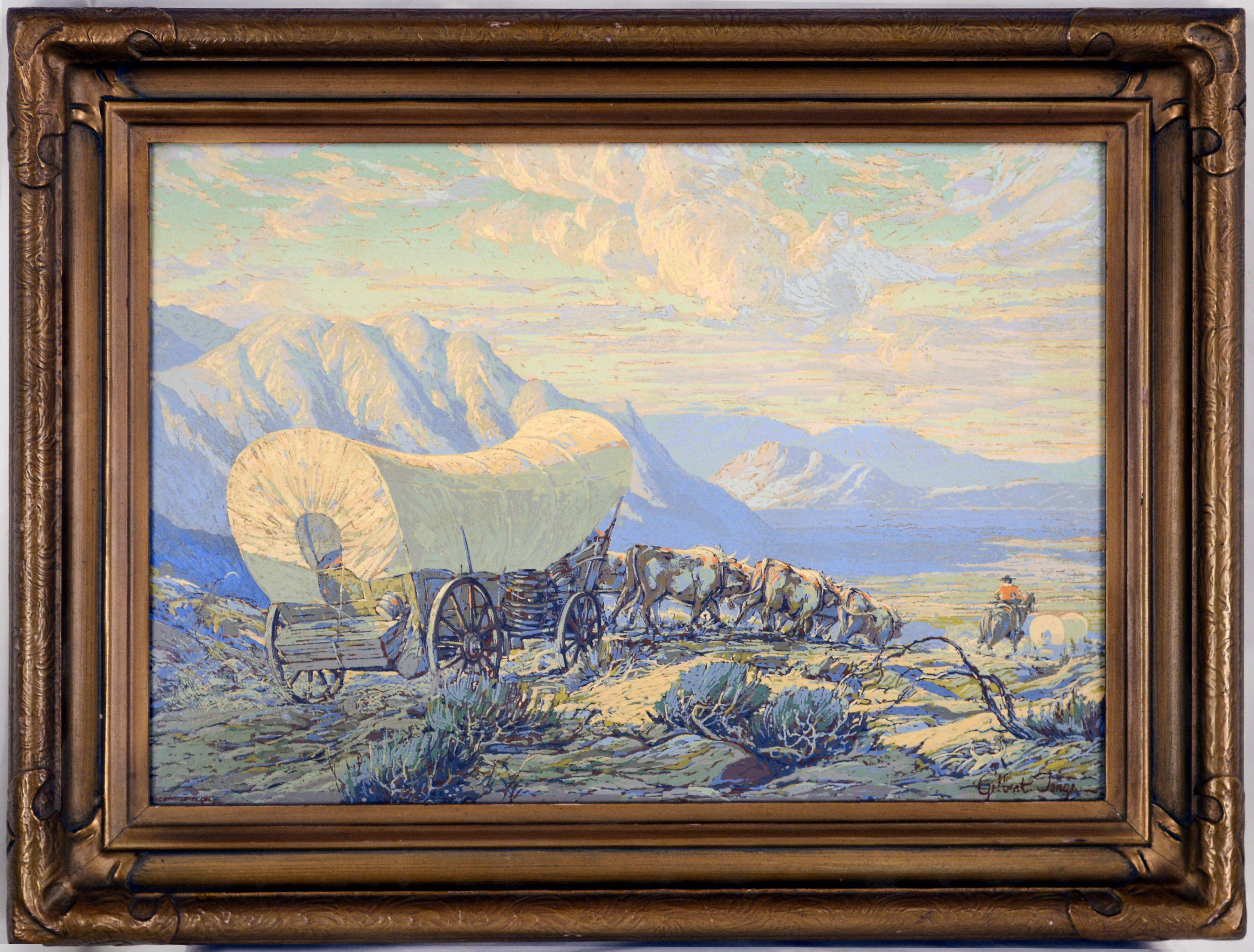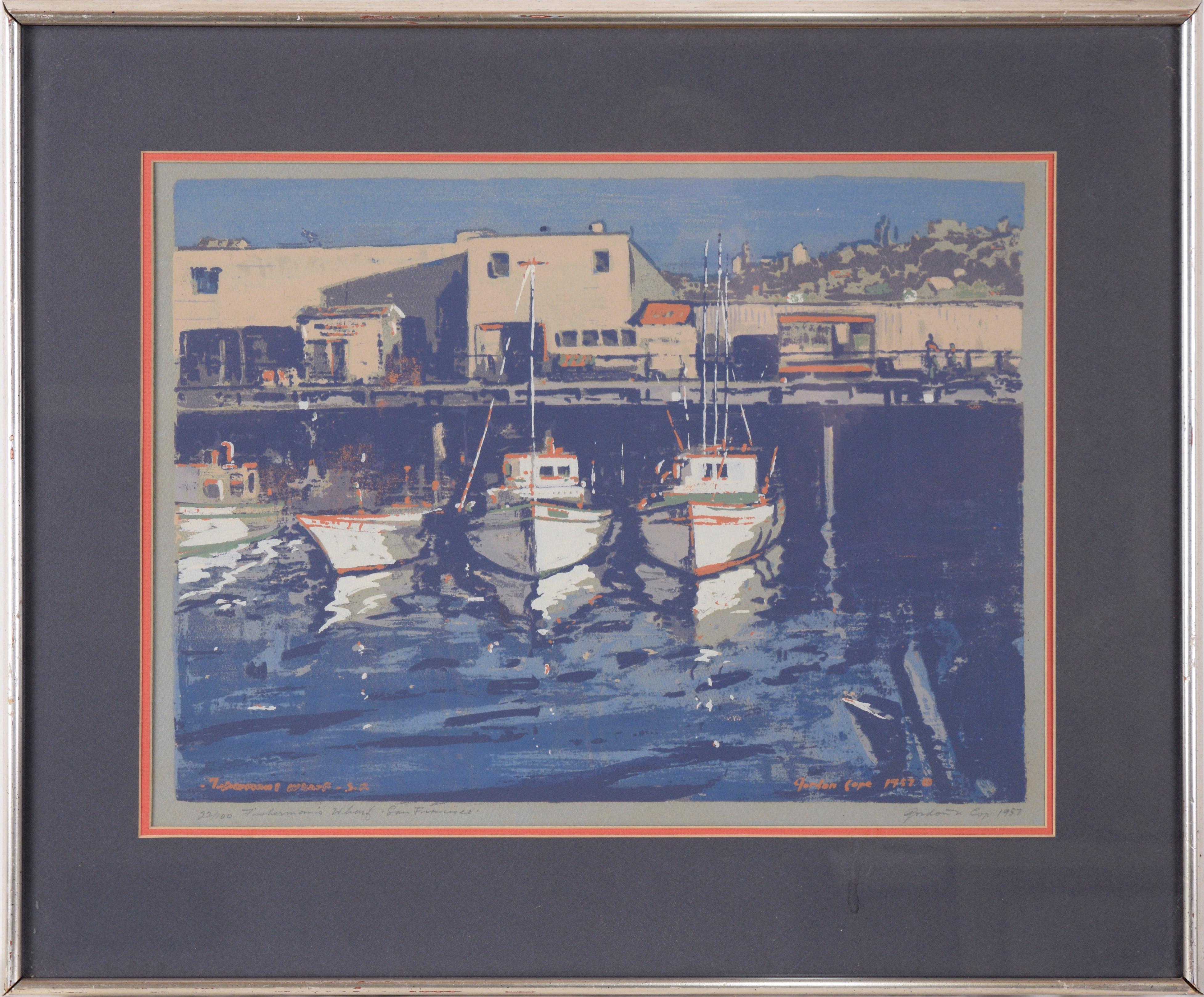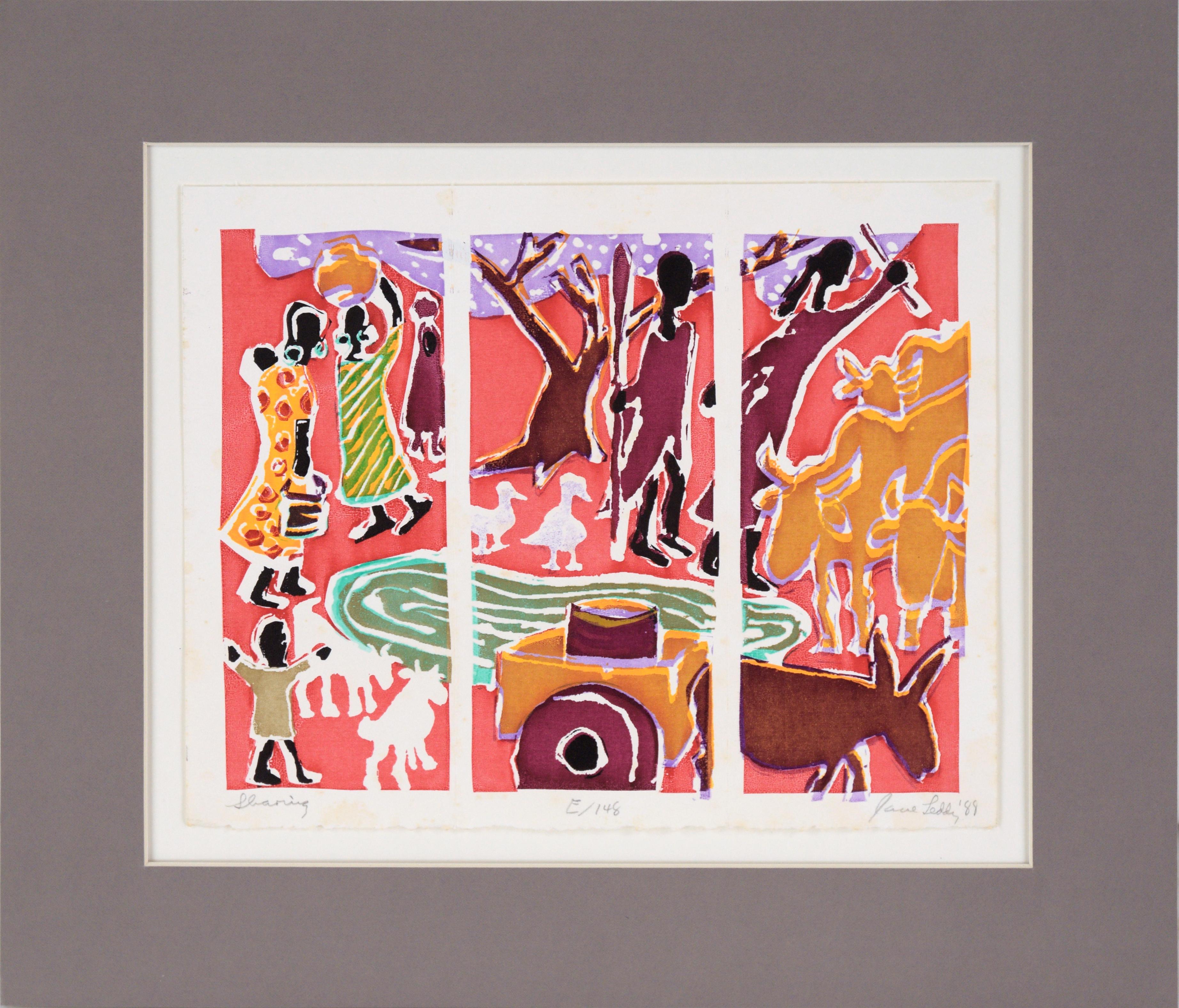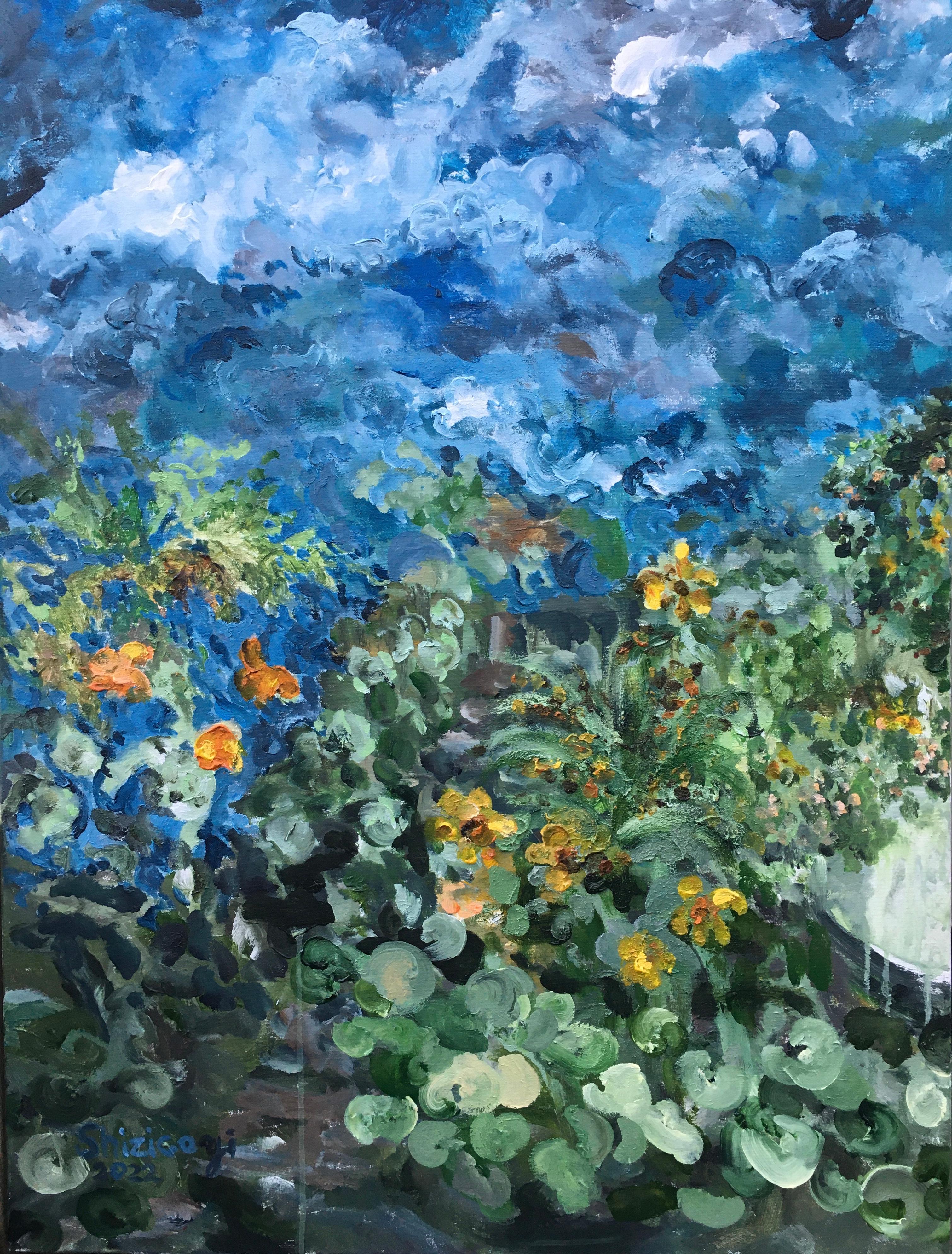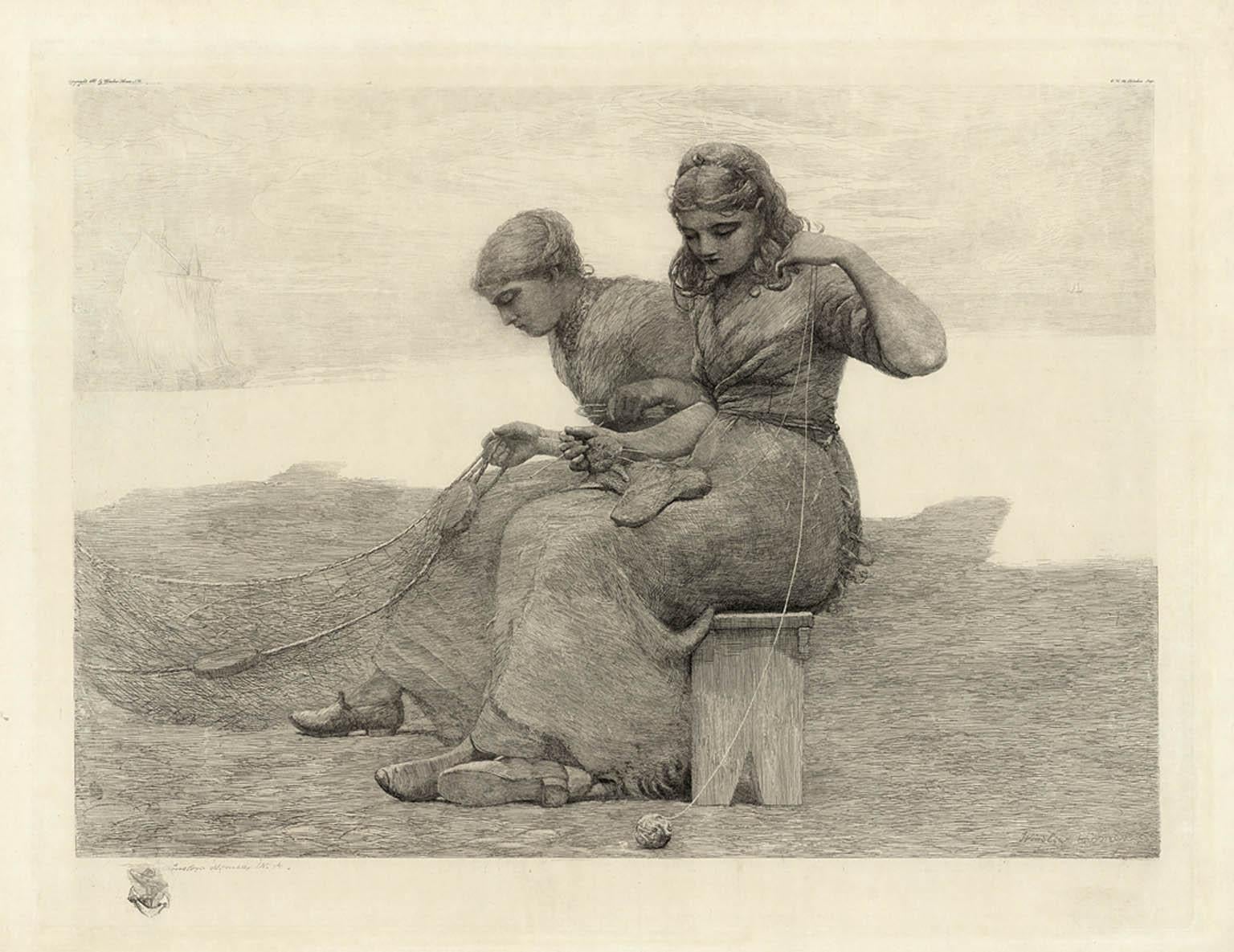Items Similar to "Home from the Fair" Wagon and Horses Print on Canvas
Want more images or videos?
Request additional images or videos from the seller
1 of 14
Jack Terry"Home from the Fair" Wagon and Horses Print on Canvas1988
1988
About the Item
"Home from the Fair" Wagon and Horses Print on Canvas
Colorful print on canvas with additional oil brush strokes for detail by Texas artist Jack Terry (American, Born 1952). Limited hand signed edition of 108/250 hand embellished canvas prints.
Hand signed in gold pen lower right "Jack Terry 108/250"
Also signed in print "Jack Terry 1988"
Ink Stamp on Canvas "Jack Terry hand Painted Canvas Print"
Brass plaque center on linen "Home From the Fair"
Image, 16"H x 20"W
Frame, 24"H x 28"W x 2.5"D
Jack Terry’s paintings evoke emotion in the viewer encompassing subject matter, use of color, mood and grace of light. He is one of the most collected artists of our time.
Jack was born in the west Texas town of Sweetwater in 1952 and began his art career as a young child, winning his first of many awards at the age of nine. A fourth-generation Texan, he credits much of his inspiration to his maternal Grandfather, Bill Mason, a rancher who cowboyed on some of the last cattle drives of the west and his paternal Grandmother, Etna Terry, who began painting late in life and welcomed young Jack to participate in the fun. Six-time world champion Cowboy Larry Mahan has said of Jack, “Terry captures the West the way it was and the way it should be. He is one of the finest artists of our day and a pretty good cowhand to boot…”.
A graduate of the University of Texas, Jack studied studio art, anatomy, design and journalism while displaying his paintings in various galleries throughout the state. Upon graduation, he began painting full-time, taking every opportunity to day-work on various ranches in search of inspiration, new subject matter and authenticity.
In 1976, at the young age of 24, Jack Terry was named Bicentennial Artist in Texas. He was honored with a one-man show in the state Capitol Rotunda. His portrait of President Lyndon Johnson was commissioned for publication on the Texas Bicentennial Calendar that same year.
In 1999, Harvest House Publishers invited Jack to write and illustrate his first book. “The Great Trail Ride”, a collection of 14 inspirational short stories. The great success of that first title led to eight more books which sold over one million copies.
In 2008 First Lady Laura Bush invited Jack to the White House for the Holiday Celebration. He painted a Christmas tree ornament representing the state of Texas.
In 2010 the United States Army commissioned a painting honoring the First Air Calvary Division and the brave men and women who have served from the historic beginning of the U.S. Calvary, Viet Nam and the Middle East. Limited edition reproductions were signed by Jack, Medal of Honor Recipient Bruce Crandall from the Viet Nam War, and General Dick Cody, Vice Chief of Staff, U.S. Army. Jack responded about this special occasion in 2010, “After months of research, flying time and researching films and most importantly sitting at the same table with these heroes whose commitment, loyalty and sacrifice to our great nation have made this the most meaningful painting I have ever done”.
Jack Terry’s paintings hang in prominent collections throughout the country. The King Ranch, Exxon-Mobil, actor Burt Reynolds, producer Dick Clark, singers Tammy Wynette and Travis Tritt, Legendary Dallas Cowboy and NFLHOF linebacker Bob Lily, PGA champion Hal Sutton, Texas Governor Ann Richards and President George W. Bush. Jack’s art has been featured in such magazines as Western Horseman, Southwest Art, Western Art Collector, Art-Talk, Cowboys and Indians and Collectors Mart.
“I have been so blessed to have enjoyed the gift of art since childhood. My career has taken me to many beautiful places across the world and introduced me to countless wonderful people. I have been blessed to study with such great artists as Dalhart Windberg, James Boren, Melvin Warren, Robert Pummill and Howard Terpning. I have never considered myself a great historian nor one who chronicles in great detail anything in particular. I simply take great joy in capturing a great moment and mood in time in God’s magnificent universe and share what I see with others. I attribute the success I have had and the hearts I have touched to and the unwavering support of my family and friends and God’s great grace. I cannot thank each of you enough.”
- Creator:Jack Terry (1952, American)
- Creation Year:1988
- Dimensions:Height: 24 in (60.96 cm)Width: 28 in (71.12 cm)Depth: 2.5 in (6.35 cm)
- Medium:
- Movement & Style:
- Period:
- Condition:Edition 108/250. Excellent Print on canvas. Frame has one scrap right center retouched and included as-is.
- Gallery Location:Soquel, CA
- Reference Number:
About the Seller
4.9
Platinum Seller
These expertly vetted sellers are 1stDibs' most experienced sellers and are rated highest by our customers.
Established in 1986
1stDibs seller since 2014
2,538 sales on 1stDibs
Typical response time: <1 hour
- ShippingRetrieving quote...Ships From: Soquel, CA
- Return PolicyA return for this item may be initiated within 14 days of delivery.
More From This SellerView All
- "Drowsy Bums" - Mid Century Figurative San Francisco Dock LandscapeBy John StollLocated in Soquel, CAFigurative landscape capturing dock workers' afternoon break by John Theodore Edward Stoll (b. Germany; 1889, d. California; 1974). Signed "John Stoll" lower right. Titled "Drowsy Bu...Category
1940s American Impressionist Landscape Prints
MaterialsEtching, Paper, Printer's Ink
- "The Covered Wagon" On the Oregon Trail Prairie Schooner Horseman and CattleLocated in Soquel, CA"The Covered Wagon" On the Oregon Trail Prairie Schooner and Cattle Facsimile in oil or silk screen Oil print by Gilbert Ross Tonge (American, 1883 - 1970...Category
1940s American Impressionist Landscape Prints
MaterialsOil, Illustration Board, Screen
- "Fisherman's Wharf - San Francisco" Multi Layer Screen Print on Paper - SignedBy Gordon CopeLocated in Soquel, CA"Fisherman's Wharf - San Francisco" Multi Layer Screen Print on Paper - Signed Rare and bold Screen Print (Silk Screen) of Fisherman's Wharf 1957 by Gordon Cope (American, 1906-1999). Several boats are docked at Fisherman's Wharf, with buildings directly behind them. In the distance, the hills of San Francisco can be seen meeting a pale blue sky. Of particular note is the skillful representation of the reflections of the boats in the water, and the clever use of grey paper as negative space. Numbered and titled in pencil in the lower left corner "22/100 Fisherman's Wharf - San Francisco" Hand signed and dated in pencil in the lower right corner "Gordon Cope 1957" Titled, signed, and dated "in plate" Presented in a silver colored frame with a double mat. Frame size: 22.5"H x 27"W Image size: 15"H x 20"W Gordon N. Cope (American, 1906-1999) was an educator and painter. Trained in Utah and France, he exhibited his landscape paintings and portraits in the United States and Europe, and he believed music was related to painting. Cope was born on May 14, 1906, in Salt Lake City. He was trained by Utahn artists LeConte Stewart and Lawrence Squires, and at the Académie Julian in Paris, France in 1928. He also studied singing at the Opéra-Comique. Cope taught art at Latter-day Saints University, and he served as the chair of its Department of Art in 1930–1931. He taught at the Mountain School of Art from 1932 to 1938, and he was the director of the Art Barn School in Salt Lake City in 1939–1941. Cope painted Utahn landscapes as well as a portrait of Henry H. Blood, who served as the seventh governor of Utah from 1933 to 1941. Cope exhibited his work in the United States and Europe. According to the Deseret News, Cope "felt that music and painting are closely interrelated, and that the study of one form may be used to complement the appreciation and understanding of the other." Cope died on June 10, 1999, in San Francisco, California. Gordon Nicholson Cope studied with well-known Utah artists A.B. Wright and LeConte Stewart, and became recognized as a major Utah artist of the Great Depression. Cope was born in Salt Lake City in 1906 and spent much of his life in Utah. Cope gained much of his artistic training from diverse environments and influences. Following his training with the previously mentioned artists, Cope spent the next year, 1924, working with Lawrence Squires in Arizona. To expand his knowledge and training, Cope traveled to Europe, where he studied the "old masters" such as Da Vinci, Michelangelo, and Raphael. From 1924 to 1928, Cope studied in England, France, Italy, Switzerland, Belgium, Holland, and worked for a year at the Acadamie Julian, where many early Utah artists...Category
1950s American Impressionist Landscape Prints
MaterialsScreen, Paper, Ink
- "Sharing" Multi Layer Screen Print on PaperLocated in Soquel, CAVibrant screen print of people gathering around a pond by Jane Leddy (American, 1925-2019). People and various animals - including goats, ducks, and cows - ...Category
1980s American Impressionist Figurative Prints
MaterialsPaper, Ink, Screen
- "Under the Apple Tree", Figurative Chromolithograph after George Niles, 188/250By Louis PrangLocated in Soquel, CAOriginal chromolithograph by Louis Prang (German/American, 1823-1909) of L. Prang & Co. (American, founded 1860), after "Under the Apple Tree" by George E. Niles (American, 1837-1898). This late 19th century figurative chromolithograph depicts a small boy in a country setting and period dress under an apple tree, reaching into a barrel with a basket of apples spilling into the grass. A German style chromolithograph, this limited edition 188/250 print was created with heavy, oil-based inks which were applied in several layers to impart a texture similar to an original oil painting. Signed and dated in the plate "G.E. Niles 1867". Tag on verso with "Prang's American Chromos - Under the Apple Tree, after Niles - Chromolithographed and published by L. Prang & Co. ...Boston". Displayed in a rustic giltwood beveled frame. Image size: 9"H x 7.25"W. Louis Prang was a foremost lithographer and publisher in New York City from the mid to the end of the 19th Century. Born in Breslau, Germany to a father who was a calico printer, he was an apprentice to his father during his teen-age years and then spent five years as a journeyman, learning printing and dyeing and living in Austria, France and England. However, Prang's liberal political vliews caused him to be deported by the Prussian government during the Revolution of 1848, and fled via Bohemia and Switzerland to get to America. In 1850, Prang went to Boston, having stopped briefly in New York City, and became a publisher and taught himself wood engraving. In 1856, he turned to lithography in partnership with Julius Mayer. In 1860, he founded Louis Prang and Co., which was his own company and the first stiff competition to Currier and Ives. A primary reason for this competition was Prang's active imagination and energetic pursuit of his business. During the Civil War, he published maps and battle plans so that people at home could follow military movements. He also created printed card portraits of Union soldiers...Category
Late 19th Century American Impressionist Figurative Prints
MaterialsLithograph, Cardboard
- "Nativity" Modernist Landscape Screen Print in Ink on Paper -Located in Soquel, CA"Nativity" Modernist Landscape Screenprint in Ink on Paper Whimsical modern landscape silkscreen print of the nativity scene by San Francisco, C...Category
1970s Modern Figurative Prints
MaterialsPrinter's Ink, Screen, Paper
You May Also Like
- Having a cigarette amongst Green and Blue, hand painted Edition #6 large CanvasLocated in London, GBHand painted finishing Limited Edition ( #6 of 20 ) Museum archival quality on Canvas Edition . Hand painted finishing by the artist Shizico Yi, with original brushstroke and oil pai...Category
2010s Impressionist Landscape Prints
MaterialsGesso, Canvas, Archival Ink, Acrylic, Stretcher Bars, Oil
- Mending the TearsBy Winslow HomerLocated in New York, NYWinslow Homer created this etching entitled “MENDING THE TEARS” in 1888. This is a lifetime impression signed by Homer and printed by the famous New York etcher George W. H. Ritchie...Category
1880s American Impressionist Figurative Prints
MaterialsEtching
- "Woman, Boy and Goats", Original Signed Etching by John E. CostiganBy John CostiganLocated in New York, NYThis original, limited edition etching, was realized by the esteemed American artist John E. Costigan, who is represented in the collections of the Metropolitan Museum, the Philips Memorial Gallery in Washington and the Brooklyn Museum, to name only a few of the many institutions that feature his work. This print, with its highly considered composition and its loose style of figuration- deftly balances realism and abstraction- helps to explain his acclaim. This etching features a mother walking with her child and two goats in a forested glen. It is a Classic pastoral scene rendered in Costigan's inimitable style- somewhere between Theodore Rousseau and Thomas Hart Benton. These offer a beautiful glimpse of a bygone American pastoral...Category
1930s American Impressionist Figurative Prints
MaterialsEtching
- Santa Fe The Chief Way original American railroad posterLocated in Spokane, WAOriginal Santa Fe The Chief Way vintage railroad travel poster. Archival linen backed in very fine condition, ready to frame. Most of the Santa Fe Railway posters feature American Indians, but this poster features the big boss, The Chief! The poster has about a 1" white border around the entire image, the linen backing is not counted in the poster's measurement. Several of the trains were named "Chief" which includes the San Francisco Chief, Texan Chief, Kansas City Chief...Category
1940s American Impressionist Figurative Prints
MaterialsOffset
- "Skating on Ladies' Pond Central Park": Winslow Homer 19th C. Woodcut EngravingBy Winslow HomerLocated in Alamo, CAThis Winslow Homer woodcut engraving entitled "Skating on the Ladies' Skating-Pond in Central Park, New York", was published in Harper's Weekly in the January 28, 1860 edition. It depicts a large number of men, women and children skating on a recently opened pond in Central Park. At the time of publication of this engraving, Central Park was in the early stages of construction. This engraving documents the very early appearance of Frederick Law Olmstead and Calvert Vaux's masterpiece of landscape design. According to Olmsted, the park was "of great importance as the first real Park made in this century – a democratic development of the highest significance". The people of New York were very proud of the plans for their park. It was stated at the time: "Our Park, which is progressing very satisfactorily under the management of the Commissioners, will undoubtedly be, one of these days, one of the finest place of the kind in the world...Those who saw the Park before the engineers went to work on it are amazed at the beautiful sites which have been contrived with such unpromising materials; all fair persons believe that the enterprise is managed with honesty and good taste." Skating was rapidly rising in national popularity in part due to the opening of Central Park’s lake to skaters on a Sunday in December 1858 with 300 participants. The following Sunday it attracted ten thousand skaters. By Christmas Day, a reported 50,000 people came to the park, most of them to skate. There were rules governing who could use the skating pond. “The Ladies’ Pond...Category
1870s American Impressionist Landscape Prints
MaterialsWoodcut, Engraving
- Over Cape CodBy Frank W. BensonLocated in New York, NY"Over Cape Cod" is an etching created by Frank W. Benson in 1932. Benson only printed trial proofs of this plate - there is no edition. This impression is a first state of four. There are six impressions of the first state, three impressions of the second, four impressions of the third, and eight of the fourth state have been recorded. Signed in pencil in the lower left under the image. The image size is 7 15/16 x 14 7/8" (20.1 x 37.8 cm) and sheet size 11 9/16 x 18 3/8" (29.3 x 46.7 cm). FRANK W. BENSON (1862-1951) Frank Weston Benson, well known for his American impressionist paintings, also produced an incredible body of prints - etchings, drypoints, and a few lithographs. Born and raised on the North Shore of Massachusetts, Benson, a natural outdoorsman, grew up sailing, fishing, and hunting. From a young age, he was fascinated with drawing and birding – this keen interest continued throughout his life. His first art instruction was with Otto Grundman at the Museum of Fine Arts in Boston, and then in 1883 in Paris at the Academie Julian where he studied the rigorous ‘ecole des beaux arts’ approach to drawing and painting for two years. During the early 1880’s Seymour Haden visited Boston giving a series of lectures on etching. This introduction to the European etching...Category
Mid-20th Century American Impressionist Figurative Prints
MaterialsEtching
